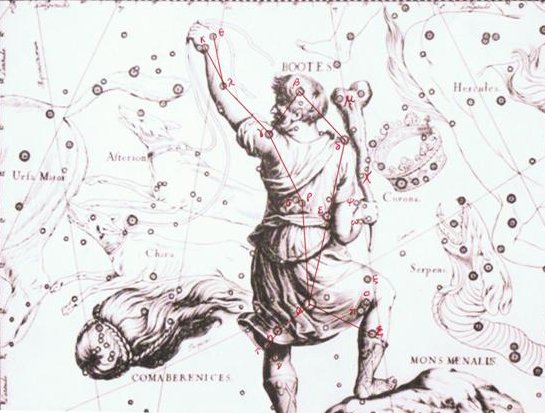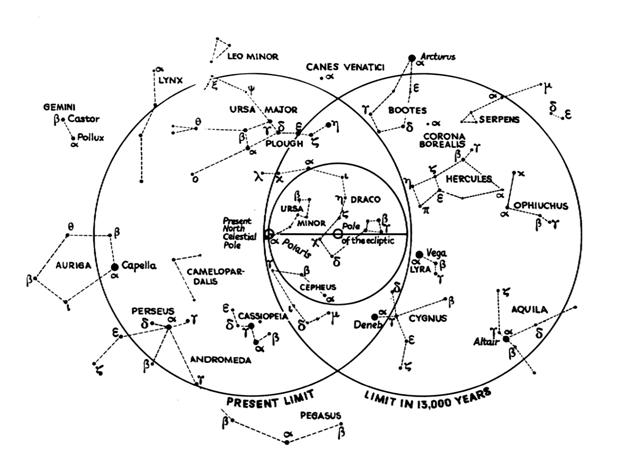2. The dominant figure in the 15th hour is Bootes. The pedant will use the name Boötes, but I do not care. "The name comes from the Greek Βοώτης, Boōtēs, meaning herdsman or plowman (literally, ox-driver; from boos, related to the Latin bovis, 'cow'). The 'ö' in the name is a diaeresis, not an umlaut, meaning that each 'o' is to be pronounced separately." (Wikipedia)
Hevelius has drawn the preceding Coma Berenices as if it was an appendage to Bootes. "The drawing of Heis, after Dürer, is of a mature man, with herdsman's staff, holding the leash of the Hounds; but earlier representations are of a much younger figure: in all cases, however, well equipped with weapons of the chase, or implements of husbandry; the earliest form of these probably having been the winnowing fan of Bacchus." (Allen) The position of Bootes in the year, after Spica (the ear) and the yellow 'treshes' of Queen Berenice, points at the time of winnowing: "Wind winnowing is an agricultural method developed by ancient cultures for separating grain from chaff. It is also used to remove weevils or other pests from stored grain. Threshing, the separation of grain or seeds from the husks and straw, is the step in the chaff-removal process that comes before winnowing ... In its simplest form it involves throwing the mixture into the air so that the wind blows away the lighter chaff, while the heavier grains fall back down for recovery. Techniques included using a winnowing fan (a shaped basket shaken to raise the chaff) or using a tool (a winnowing fork or shovel) on a pile of harvested grain ... The winnowing-fan (λίκνον [líknon], also meaning a 'cradle') featured in the rites accorded Dionysus and in the Eleusinian Mysteries: 'it was a simple agricultural implement taken over and mysticised by the religion of Dionysus', Jane Ellen Harrison remarked. Dionysus Liknites ('Dionysus of the winnowing fan') was wakened by the Dionysian women, in this instance called Thyiades, in a cave on Parnassus high above Delphi; the winnowing-fan links the god connected with the mystery religions to the agricultural cycle, but mortal Greek babies too were laid in a winnowing-fan. In Callimachus' Hymn to Zeus, Adrasteia lays the infant Zeus in a golden líknon, her goat suckles him and he is given honey. In the Odyssey, the dead oracle Teiresias tells Odysseus to walk away from Ithaca with an oar until a wayfarer tells him it is a winnowing fan, and there to build a shrine to Poseidon." (Wikipedia) The last remark could maybe connect, I think, the rudder (steering oar) of Argos with the 14th hour. From Naos (122.3) to Thuban (213.8) there is a quarter (91 days). Once upon a time Thuban (α Draconis) was the star at the pole (cfr at King Cepheus):
From Rei in Ga2-27 (where we read 22 / 7 → 314) to day 214 beyond equinox there are 92 days:
However, 59 + 91 = 150 and 150 + 210 = 360:
| ||||||||||||||||||||||||||||||||||||||||||||||||||||||||||||||||||||||||||||






